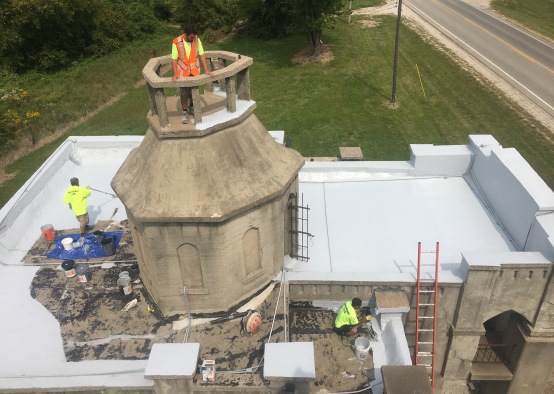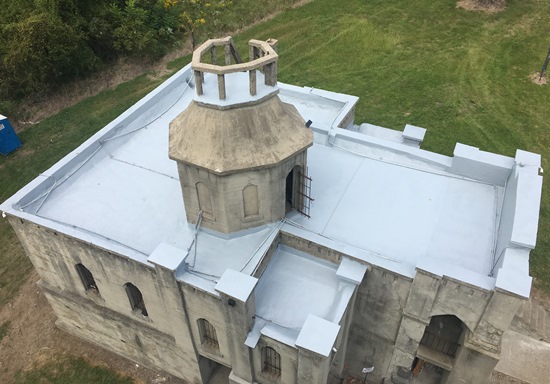If you visited Holden, Missouri and you happened to drive along Highway 131, you likely would have seen a strange looking building and wondered what it was. It is all concrete and looks like a miniature castle, with concrete pillars in front, three arches over the doorway, and what look like arrow slits along the top. All it needed was a drawbridge, a moat, and maybe a dragon.
“Some think it might be a home, others believe it might have been for religious purposes, and children think it might have been a jail,” said Carl Cranfill, the owner. In fact, it is none of those things. It is a mausoleum built by Cranfill’s great grandfather, Joseph Marion Miller, a retired teacher and farmer.
Soon after Miller moved to Holden in 1915, he began work on building the mausoleum. In 1918, the first vault was finished and people in town began to call it “Joseph’s Tomb.”
It took 10 years to finish, and when it was done it included two vault rooms with 48 crypts.
The purpose of the mausoleum was for it to house Miller’s family when they were laid to rest. Only 15 of those crypts were ever occupied, and recently the bodies were moved to a local cemetery. And it was discovered that the 100-year-old structure was in need of protection.
Historic Decisions
The mausoleum was built from cement and stone, and it was reinforced with steel. The walls of the first story are 3-feet (0.9 m) thick, and the second story is 2-feet (61.0 cm) thick.
On the top is a dome with a flattened portion that serves as an observation platform.
Cranfill decided the mausoleum needed to be insulated, so he reached out to Richard Tooley, the owner of Kansas City, Kansas-based Elite Roof Systems LLC. The company of 15 to 30 employees has 75 years of experience and applies roof coatings to all types of commercial and flat roofs.
“He called me and said, ‘I’ve been researching spray polyurethane foam [SPF] roofs and I think that would be a good fit for my project,’” Tooley said. “When I got out there to look at it, he told me there’s foot traffic on the roof, people are walking on it, there’s a little guard gate that opens onto the roof, and I said there’s no room to install a foam roof.”
“Plus, I told him there’s no reason to install a spray foam roof because it’s not a heated or cooled building; there’s no one living in it,” Tooley continued. “So we talked about different systems, I presented a couple different options and he got back to me a few months later and decided to go with a coating system.”
Already, there was a wrinkle. Cranfill was planning to apply to get the mausoleum designated by the local historical society as a historic monument. The society told him to insulate the roof before that application.
“Because otherwise it was going to be mass hysteria on getting it approved,” Tooley said. If he waited until after the building was designated, Cranfill’s only option would be to seal the concrete.
“And that wouldn’t protect the building at all,” Tooley said.
The work was then scheduled for about two months later.

“During that time the owner had installed electrical lighting and cameras on the roof in conduit and junction boxes that were all mounted into the concrete that we were supposed to coat,” Tooley said. “Some of it had to be removed and some of it had to be worked around to get a 100 percent seal on the concrete.”
Another challenge to the job was the condition of the concrete itself — not so much on the roof but the walls of the mausoleum.
“The concrete was so old and pitted, it was a challenge to seal it up,” Tooley said. “It had so many small pits in it the size of an acorn, so everything had to be sealed up and fixed before we could proceed with the coating. There was a lot of prep work.”
Colorful Coatings
To prep the surface and get it ready for coating, Tooley’s crew used different kinds of epoxy and urethane mastic to seal it.
Then they were ready to put down the coating. The total surface area to cover was 1,800 square feet (167.2 m²) and required a crew of three men.
The job called for a 100 percent urethane coating system, and the crew used all products from EverRoof. First, the crew applied Primer M100, a two-part epoxy primer, followed by crack repairs using Roof Flash Mastic, which is a thick urethane material. All of this was applied with 4-inch (10 cm) brushes from Big Rock over the cracks to an average thickness of 24 mils (609.6 microns).
The next step was a coat of urethane, which was Ever-Thane Water-Lok in terra cotta red applied at 1.5 gallons (5.7 L) per 100 square feet (9.3 m²), followed by a coat of Ever-Thane Base in blue applied at 1.5 gallons (5.7 L) per 100 square feet (9.3 m²). Granules were broadcast in this coat for slip resistance.
The final coat was Ever-Thane Overglaze in a dolphin grey color. This coat was an aliphatic color-stable product. The final coat was also applied at 1.5 gallons (5.7 L) per 100 square feet (9.3 m²). The combined coatings system created a 5.5-gallon (20.8 L) urethane system or an average thickness of 60 dry mils (1,524.0 microns).
Tower of Holden
“Safety on this job was different than our typical application,” Tooley said. “Due to the small size of the project, we couldn’t utilize cones and bases with flags around the perimeter so we used a competent safety monitor for the duration of the project. There is a short tower on the top of the mausoleum roof that we had the safety monitor stay on for most of the project to identify any safety issues.” They used a lift from Lizzy Lift to access the roof.
The job took about six days to finish, but once work began it went smoothly.
“This project was out in the county, not near any city or town,” Tooley said. “There weren’t any environmental concerns on this project.”
“Everything went off without a hitch; the job went really smoothly,” Tooley added. And the owner, Cranfill, was also pleased. “A very professional work crew did an excellent job,” he said. They’re “very friendly and definitely would hire them again. Thanks for taking extra care with this National Historic Place.”
In the end, the Elite Roof Systems crew can say they’re now a part of history, which Tooley said he enjoyed being a part of.
